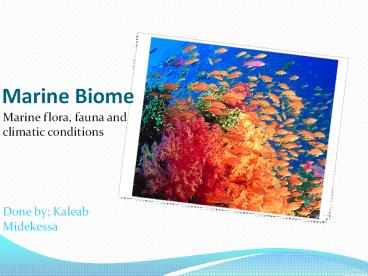marine biome - PowerPoint PPT Presentation
Title: marine biome
1
Marine Biome
- Marine flora, fauna and climatic conditions
- Done by
Kaleab Midekessa
2
Marine biome
- Marine regions cover about three-fourths of the
Earth's surface and include oceans, coral reefs,
and estuaries. - Marine algae supply much of the world's oxygen
supply and take in a huge amount of atmospheric
carbon dioxide. - The marine biome is made up of three layers The
euphotic zone, the disphotic zone, and the
aphotic zone. - The euphotic zone is where the most life is,
because that's were sunlight pierces. - The disphotic zone is dark and gloomy, and
doesn't harvest as much life but still contains a
large number.The third zone, the aphotic zone, is
home only to the plants and animals that have
adapted to the extreme to life in such harsh
conditions.
3
(No Transcript)
4
Oceans
- The largest of all the ecosystems, oceans are
very large bodies of water that dominate the
Earth's surface. - The Ocean has different zones. These are
intertidal, pelagic, abyssal, and benthic. - All four zones have a great diversity of species.
5
(No Transcript)
6
Intertidal zone
- The intertidal zone is where the ocean meets the
land. - There are only a few species of algae and
mollusks. - In those areas usually submerged during high
tide, there is a more diverse array of algae and
small animals, such as herbivorous snails, crabs,
sea stars, and small fishes. - At the bottom of the intertidal zone,, many
invertebrates, fishes, and seaweed can be found. - The fauna include worms, clams, predatory
crustaceans, crabs, and shorebirds.
7
Pelagic Zone
- The pelagic zone includes those waters further
from the land, basically the open ocean. - The pelagic zone is generally cold.
- The flora in the pelagic zone include surface
seaweeds. - The fauna include many species of fish and some
mammals, such as whales and dolphins. Many feed
on the abundant plankton.
8
Abyssal Zone
- The deep ocean is the abyssal zone. The water in
this region is very cold (around 3 C), highly
pressured, high in oxygen content, but low in
nutritional content. - The abyssal zone supports many species of
invertebrates and fishes. - Chemosynthetic bacteria thrive near these vents
because of the large amounts of hydrogen sulfide
and other minerals they emit. - These bacteria are thus the start of the food
web as they are eaten by invertebrates and fishes.
9
Benthic zone
- The benthic zone is the area below the pelagic
zone, but does not include the very deepest parts
of the ocean. - The bottom of the zone consists of sand, slit,
and/or dead organisms. Here temperature decreases
as depth increases toward the abyssal zone, since
light cannot penetrate through the deeper water. - Flora are represented primarily by seaweed while
the fauna, since it is very nutrient-rich,
include all sorts of bacteria, fungi, sponges,
sea anemones, worms, sea stars, and fishes.
10
Marine Flaura
- The smallest marine plants are phytoplankton,
which are single-celled and form the basis of the
marine food chain. - Few marine plants are angiosperms, although
along tropical coasts, flowering marine plants
often accumulate. - Green algae (Chlorophyta) is the most common
marine plant. Chlorophyll causes these algae to
have bright green coloring. - Red algae (Rhodophyta), tinted by the pigment
phycoerythrin, are the largest type of marine
plants and the most diverse. Some red algae
adhere to corals, thus creating reefs.
11
Other Marine Flaura
Algae coralline
Algae Dead mans fish
12
Algae-Green-Grape
Algae-Green-Feather
13
Algae-Papyrus-Print
Algae-Leafy-Flat-Blade
14
Marine Fauna
- Great White Shark
- Perhaps the most formidible predator of the open
ocean. The great white is notorious and is the
subject of many myths and legends.
15
- Whale Shark
- Much more placid than its infamous cousin, the
whale shark is the largest species of fish on the
planet. - Hawksbill sea Turtle
- The shell trade once decimated populations of
this turtle. However, populations are gradually
recovering.
16
- Bottlenose Dolphin
- Perhaps the most familiar member of the cetacean
family, the bottlenose dolphin is one of the most
intelligent sea animals.
17
Climatic Conditions
- The climate of the marine biome is mostly
varied. Since it is the largest biome in the
world, the climate varies from -40 degrees
fahreheit to over 100 degrees. - The average temperature is 39 degrees
fahrenheit, but it is warmer near the equator
where the direct rays of sun can pierce the water
and warm it. The coldest is in the north and
south poles, where the water is close to freezing
if not frozen (Glaciers). Also, the deeper the
ocean is, the colder the water will be because
the sunlight isn't directly piercing it.
18
Rainfall
More than half of the world's rain fall over the
ocean for two reasons One, it's so large, and
two, the water cycle runs faster because the
biome is made of water. The average yearly
precipitation can add up to over 100 inches.
19
(No Transcript)































